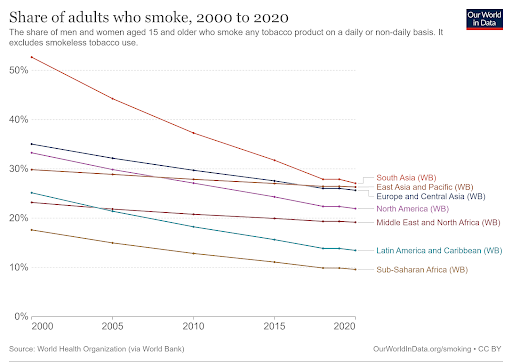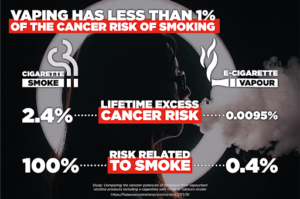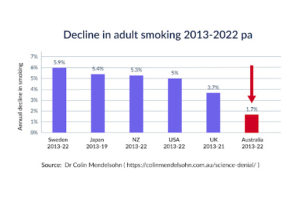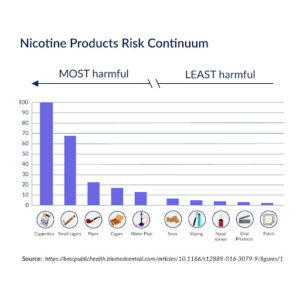Il fumo è un problema globale. Ci sono circa 1,3 miliardi di consumatori di tabacco nel mondo. Finora, gli approcci tradizionali per smettere di fumare si sono dimostrati ampiamente inefficaci. Dall'avvento dei prodotti alternativi al fumo a base di nicotina, abbiamo assistito a enormi progressi nella riduzione dei tassi di fumo in tutto il mondo. Ad esempio, la Svezia, un paese con una lunga tradizione nella promozione dello snus, ma anche delle bustine di nicotina e dello svapo, viene celebrata per essere stata la prima nazione al mondo a diventare libera dal fumo. Il Regno Unito ha ridotto i tassi di fumo di quasi il 50% tra il 2015 e il 2021, anno in cui Public Health England ha approvato pubblicamente lo svapo., Stiamo ora lanciando un programma nazionale per incoraggiare i fumatori a rinunciare alle sigarette tradizionali, sostituendole con una sigaretta elettronica gratuita. È stato dimostrato che la riduzione del danno è un fattore trainante nella lotta globale contro il fumo.

Questa scheda informativa si propone di fare luce sulla questione dello svapo e della riduzione dei danni causati dal tabacco, offrendo una panoramica completa delle ricerche scientifiche e delle politiche normative più rilevanti e aggiornate in tutto il mondo.
Che cosa si intende per riduzione del danno?
La riduzione del danno mira a minimizzare gli impatti negativi di un'attività. Proprio come cinture di sicurezza e caschi aumentano la sicurezza alla guida, la riduzione del danno ricerca soluzioni pratiche anziché ideali irrealistici. Dà priorità a soluzioni praticabili per mitigare efficacemente i rischi.
Perché lo svapo riduce i danni?
In termini di riduzione del danno da tabacco, lo svapo si distingue come un esempio lampante. Sebbene l'astinenza completa possa essere ciò a cui alcuni consumatori aspirano, spesso è irraggiungibile. Data la diffusa domanda di nicotina, come dimostra l'esistenza di milioni di fumatori, lo svapo offre un modo per dissociare il consumo di nicotina dagli aspetti più dannosi del fumo. Pur non essendo completamente privo di rischi, lo svapo riduce significativamente i danni rispetto al fumo, rendendolo una valida alternativa per i fumatori che desiderano mitigare il proprio rischio personale.
Svapare è meno dannoso che fumare?
SÌ. Ci sono ben oltre 100 organizzazioni e istituzioni governative che concordano sul fatto che svapare sia meno dannoso del fumare.
Svapare aiuta a smettere di fumare?
SÌ. Una nuova revisione sistematica delle prove, che include 78 studi completati dall'Organizzazione non governativa britannica per la salute pubblica, Cochrane, ha confermato che svapare aiuta i fumatori a smettere. Le revisioni sistematiche Cochrane sono riconosciute a livello mondiale come il gold standard in materia di prove scientifiche sulla salute.
Come dovrebbe essere regolamentato lo svapo?
Ciò di cui abbiamo bisogno è un regolamentazione basata sul rischio. Svapare è 95% meno dannoso del fumo
e non devono essere trattate allo stesso modo. Le alternative meno dannose dovrebbero essere meno regolamentate rispetto al prodotto più dannoso sul mercato: le sigarette.
Di seguito sono riportati gli studi più rilevanti raccolti nei seguenti ambiti:
Ogni capitolo include alla fine una sezione di riferimenti bibliografici in cui sono raccolti tutti gli articoli accademici citati.
La ricerca ha dimostrato che, sebbene non sia completamente innocuo, lo svapo è molto meno dannoso del fumo. Il rischio di cancro rispetto al fumo è praticamente inesistente. Ecco le principali prove sugli effetti sulla salute dello svapo rispetto al fumo:

Ci sono prove sufficienti per concludere non solo che svapare aiuta a smettere di fumare, ma anche per affermare che svapare è uno degli aiuti più efficaci per farlo. Lo svapare è un raccomandato mezzi per smettere di fumare per i fumatori in Francia, IL Regno Unito, Canada, E Nuova Zelanda; ed è stato fondamentale nel ridurre i tassi di fumo nei paesi che hanno un approccio basato sull'evidenza nei suoi confronti, come nel Regno Unito, dove il fumo è ai minimi storici. Ecco la ricerca principale:

Ad oggi, lo svapo è l'aiuto più efficace per smettere di fumare, come ha concluso la rinomata ONG sanitaria Cochrane nella sua ultima meta-analisi condotta da Lindson e altri (2023).
Lo svapo come strumento di accesso al fumo per gli adolescenti è uno dei miti più preoccupanti in materia di controllo del tabacco. Tuttavia, esistono poche o nessuna prova che stabilisca una connessione tra lo svapo giovanile e il fumo tradizionale. Esistono molte altri motivi per cui i giovani fumano. Diamo un'occhiata a ciò che la scienza è riuscita a dimostrare:
A parte la mancanza di prove che colleghino lo svapo tra i giovani al fumo, i dati mostrano che sia i tassi di fumo che quelli di svapo tra i giovani sono diminuiti in molti Paesi negli ultimi anni. I dati di Action on Smoking and Health (ASH) UK mostrano che i tassi di fumo tra i giovani sono ai minimi storici e dati provenienti dal Ufficio per le statistiche nazionali dimostra che lo svapo tra i giovani è raro tra coloro che non hanno mai fumato. La maggior parte degli utenti sono fumatori attuali o ex fumatori. Negli Stati Uniti, dove sentiamo spesso parlare della cosiddetta "epidemia di svapo", lo svapo tra i giovani caduto in modo significativo negli ultimi anni.
Prof. Polosa et al. (2022)²⁵ ha riassunto il modello di utilizzo dello svapo da parte dei giovani come segue: “"L'uso di sigarette elettroniche è aumentato notevolmente tra gli studenti delle scuole superiori e i giovani adulti nell'ultimo decennio, ma fortunatamente è diminuito significativamente dal picco del 2019. Nello stesso periodo, i tassi di fumo sono costantemente scesi a nuovi minimi storici. Queste tendenze sconsigliano di considerare l'uso di sigarette elettroniche come una via d'accesso al fumo. La maggior parte dell'uso di sigarette elettroniche è poco frequente ed è improbabile che aumenti il rischio di conseguenze negative per la salute. Inoltre, la maggior parte dell'uso di sigarette elettroniche si è verificato tra coloro che avevano già fumato."” Non si intravede alcun effetto gateway.
Gli aromi sono uno degli argomenti più controversi per quanto riguarda le politiche pubbliche sullo svapo. Si ritiene comunemente che gli aromi siano destinati agli adolescenti e poco utilizzati dagli adulti. Tuttavia, un'ampia mole di ricerche ne ha dimostrato l'importanza per gli adulti che cercano di smettere, e vi sono ampie prove che i divieti sugli aromi facciano più male che bene.
Ecco le prove sugli aromi da svapo:
Friedman e Xu (2020),²⁶ I ricercatori della Yale School of Public Health hanno associato l'uso di aromi per lo svapo a un aumento del 230% delle probabilità di smettere di fumare in età adulta e hanno concluso che: “Gli adulti che hanno svapato sigarette elettroniche aromatizzate avevano maggiori probabilità di smettere di fumare in seguito rispetto a coloro che hanno utilizzato sigarette elettroniche senza aromi. (…) Gli adulti che hanno iniziato a svapare sigarette elettroniche senza aromi di tabacco avevano maggiori probabilità di smettere di fumare rispetto a coloro che hanno svapato aromi di tabacco.”
Mendelsohn (2017),²⁷ in una relazione presentata a una commissione della Camera dei rappresentanti australiana, ha affermato che gli aromi hanno maggiori probabilità di tenere le persone lontane dalle sigarette tradizionali, poiché aiutano a dimenticare il sapore del tabacco: "Gli aromi sono una parte importante dell'attrattiva dello svapo per i fumatori adulti e rendono i prodotti attraenti come alternativa al fumo, proprio come gli aromi vengono utilizzati per aumentare l'attrattiva delle gomme alla nicotina. Vietare gli aromi comprometterebbe probabilmente l'uso delle sigarette elettroniche e la salute pubblica."“
Friedman (2020)²⁸ ha analizzato gli effetti del divieto di aromi a San Francisco e ha scoperto che ha portato a un aumento del tasso di fumo tra gli adolescenti per la prima volta in decenni.
Ricco (2022)²⁹ ha analizzato gli effetti del divieto di aromi nel Massachusetts e ha concluso che ha portato a un aumento delle vendite di sigarette.
Gravely e altri (2020)³⁰ ha intervistato gli utilizzatori di aromi non di tabacco per svapare in Canada, Regno Unito e Stati Uniti e ha scoperto che, in caso di divieto degli aromi, 5 su 10 acquisterebbero i loro aromi dal mercato nero o ricomincerebbero a fumare.
IL Fondazione Tholos (2022)³¹ hanno analizzato gli effetti del divieto di aromi in Estonia e hanno scoperto che il 60% degli svapatori ha continuato a usarli mescolando i propri liquidi o acquistandoli dal mercato nero.
Friedman e altri (2023)³² hanno studiato le restrizioni sulle sigarette ENDS aromatizzate negli Stati Uniti e hanno stimato un compromesso di 15 sigarette aggiuntive per ogni pod ENDS da 0,7 ml in meno venduto a causa delle restrizioni sugli aromi delle ENDS. Gli autori hanno concluso che “Qualsiasi beneficio per la salute pubblica derivante dalla riduzione dell’uso di ENDS attraverso restrizioni sugli aromi potrebbe essere compensato dai costi per la salute pubblica derivanti dall’aumento delle vendite di sigarette”.”
Come il SCHEER UE (2021) il rapporto concludeva: “Ad oggi non esistono dati specifici che indichino che determinati aromi utilizzati nell'UE possano rappresentare rischi per la salute degli utilizzatori di sigarette elettroniche in caso di esposizione ripetuta.”
Molti decisori politici ritengono che le tasse sui sistemi elettronici di erogazione della nicotina (ENDS) siano uno strumento in grado di ridurre l'uso dello svapo e migliorare la salute pubblica. In ogni caso, la maggior parte delle prove dimostra che gli aumenti delle tasse sulle sigarette elettroniche spingono gli svapatori a ricominciare a fumare.
Le tasse sui prodotti alternativi dovrebbero essere stabilite in base al rischio che presentano rispetto a quello delle sigarette tradizionali. Dal punto di vista degli incentivi, non ha senso tassare allo stesso modo le sigarette tradizionali e quelle elettroniche. Le tasse sulle sigarette tradizionali servono a coprire i costi sanitari e le esternalità negative derivanti dal fumo. Poiché lo svapo è meno dannoso per chi lo usa e non ha effetti negativi su chi gli sta intorno, è solo proporzionale che anche le tasse siano più basse. Questo non solo sarà sufficiente a coprire i costi sanitari derivanti dallo svapo, ma la differenza di prezzo con le sigarette tradizionali sarà un ulteriore incentivo per i fumatori a cambiare e migliorare la salute pubblica e la propria.
Si ritiene comunemente che la nicotina sia dannosa e l'idea che svapare prodotti a base di nicotina causi il cancro è altrettanto diffusa. Pertanto, si sostiene spesso che svapare nicotina sia dannoso quanto fumare. Nonostante il vapore delle sigarette elettroniche non contenga gli elementi più nocivi del fumo di tabacco, come catrame o monossido di carbonio, si ritiene che causi comunque il cancro. Tuttavia, è stato dimostrato che la nicotina è relativamente innocua:
Giorgio (2019)³⁹ hanno studiato gli effetti cardiovascolari del passaggio dal fumo allo svapo e hanno scoperto che coloro che cambiano migliorano la propria salute indipendentemente dal fatto che continuino a consumare nicotina o meno.
Foulds e altri (2021)⁴⁰ hanno scoperto che la nicotina è un fattore importante nel determinare se i fumatori sono in grado di cambiare. Gli autori hanno scoperto che lo svapo “con un rilascio di nicotina simile a quello di una sigaretta sono più efficaci nell'aiutare i fumatori ambivalenti a smettere di fumare.”
Niaura (2016)⁴¹ ha affermato che “La maggior parte dei danni fisiologici attribuibili al fumo di sigaretta deriva dalle sostanze tossiche presenti nel tabacco e nei prodotti della combustione. Morbilità e mortalità prevenibili sono state in larga parte correlate al fumo di tabacco combusto, non alla nicotina in sé. Separata dalla combustione o da altre modalità di somministrazione tossiche, la nicotina, di per sé, è molto meno dannosa.”
L'opinione che la nicotina non sia il componente dannoso dei prodotti del tabacco è stata sostenuta da diverse organizzazioni sanitarie. La British Servizio sanitario nazionale, seguendo un approccio pragmatico nei confronti del consumo di nicotina e dello svapo, ha affermato che: “"Sebbene la nicotina sia la sostanza che crea dipendenza nelle sigarette, è relativamente innocua. Quasi tutti i danni del fumo derivano dalle migliaia di altre sostanze chimiche presenti nel fumo di tabacco, molte delle quali sono tossiche."”
Allo stesso modo, Yorkshire Cancer Research ha affermato: “"La nicotina non è la causa di morte per fumo. La nicotina non è cancerogena; non ci sono prove che l'uso prolungato di nicotina da sola aumenti il rischio di cancro. Delle tre principali cause di morte per fumo (cancro ai polmoni, broncopneumopatia cronica ostruttiva e malattie cardiovascolari), nessuna è causata dalla nicotina. Il danno del fumo deriva dalle migliaia di altre sostanze chimiche presenti nel fumo di tabacco."”
Shirley Cramer, amministratore delegato della Royal Society for Public Health, disse: “Indurre le persone ad assumere nicotina invece di usare tabacco farebbe una grande differenza per la salute pubblica: chiaramente ci sono problemi in termini di fumatori dipendenti dalla nicotina, ma questo ci farebbe passare dall'avere un problema di salute pubblica serio e costoso, come le malattie legate al fumo, a affrontare invece il problema della dipendenza da una sostanza che di per sé non è poi così diversa dalla dipendenza dalla caffeina.”
Snus:
Lo snus è un sacchetto di tabacco in polvere umida e senza fumo, originario della Svezia, che si consuma posizionandolo sotto il labbro superiore. In Svezia, il consumo di snus ha superato quello delle sigarette tradizionali. La Svezia è sulla buona strada per diventare il primo Paese a raggiungere l'obiettivo di una politica senza fumo, con un tasso di fumatori attuale di 5,6%. Sebbene il consumo totale di nicotina in Svezia sia simile a quello di altri Paesi europei, la mortalità correlata al fumo è molto più bassa, come dimostrato da Clarke e altri (2019).⁴²
Fatti chiave:
Bustine di nicotina:
Le bustine di nicotina sono la più recente alternativa al fumo e, pertanto, non sono ancora adeguatamente regolamentate in molti paesi. Le bustine di nicotina vengono utilizzate in modo simile allo snus, ma a differenza di quest'ultimo contengono polvere di nicotina anziché una foglia di tabacco. Attualmente, nella maggior parte dei paesi non sono regolamentate, sono completamente vietate o sono trattate allo stesso modo delle sigarette, e nessuna di queste alternative è ottimale. Con una regolamentazione favorevole al consumatore, le bustine di nicotina potrebbero rappresentare un pilastro del nostro cammino verso una popolazione libera dal fumo.
Fatti chiave:
I prodotti alternativi alla nicotina hanno il potenziale per ridurre i tassi di fumo e migliorare la salute pubblica. Lo dimostra il fatto che i paesi con un'adozione relativamente elevata di prodotti alternativi alla nicotina, come lo svapo, il tabacco riscaldato, le bustine di nicotina e lo snus, generalmente riducono i tassi di fumo più rapidamente rispetto ai paesi che si astengono. Il Regno Unito e la Svezia dimostrano che è possibile ottenere tassi di fumo più bassi con un approccio aperto verso i prodotti alternativi alla nicotina.
Regno Unito: aiutare i fumatori a cambiare
Il Regno Unito è il paese più progressista al mondo in materia di svapo. Il governo e le istituzioni sanitarie pubbliche sostengono pienamente lo svapo come strumento di riduzione del danno e i fumatori sono incoraggiati a passare a questa alternativa meno dannosa. Nel Regno Unito, i tassi di fumo sono diminuiti di oltre il 291% nell'ultimo decennio (quando lo svapo è diventato popolare). Rispetto all'UE, i tassi di fumo nel Regno Unito sono diminuiti due volte più velocemente, secondo Fagerström (2022).⁴⁶ Quest'anno, il Regno Unito ha lanciato "Swap-to-Stop", la più grande strategia per smettere di fumare sostenuta dal governo fino ad oggi, basata sull'uso delle sigarette elettroniche.
Svezia: diventare il primo paese senza fumo grazie allo snus
In Svezia, il consumo di snus ha superato quello delle sigarette tradizionali, principalmente grazie al passaggio dei fumatori. Grazie alla sostituzione del tabacco con questa alternativa più sicura, la Svezia è sulla buona strada per diventare il primo Paese a raggiungere l'obiettivo di una politica senza fumo, con un tasso di fumatori del 5,61% a partire dal 2023. Sebbene il consumo totale di nicotina in Svezia sia simile a quello dei vicini europei, la mortalità correlata al fumo è molto più bassa, come dimostrato da Clarke e altri (2019),⁴⁷ dimostrando che lo snus è un prodotto molto meno dannoso e può migliorare la salute pubblica in generale. La Svezia sta ora cercando di accelerare questo processo riducendo la tassa sullo snus entro il 20%.
Giappone: i prodotti che riscaldano e non bruciano fanno diminuire il tasso di fumatori
I prodotti Heat-not-burn (HnB) riscaldano il tabacco e creano un aerosol inalabile invece di bruciarlo come le sigarette tradizionali. Simonavicius e altri (2019) hanno scoperto che l'assenza di combustione le rende considerevolmente più sicure delle sigarette tradizionali.⁴⁸ Grazie alla loro introduzione e diffusione in Giappone, in soli cinque anni (2016-2021), le vendite di sigarette sono crollate di 43%. Sempre più persone in Giappone stanno rifiutando le sigarette e scegliendo prodotti alternativi meno dannosi come le sigarette riscaldate e non bruciate. Il tasso di HnB in Giappone è attualmente di circa 4,5% e l'indagine sulla salute e la nutrizione ha rilevato che il 76% dei consumatori di HnB non fumava più sigarette.
Nuova Zelanda: sensibilizzare i fumatori sulle alternative più sicure
Fornire ai fumatori informazioni accurate sui prodotti alternativi può aiutarli a prendere decisioni migliori e a migliorare la propria salute. Il Ministero della Salute della Nuova Zelanda è il miglior esempio di comunicazione sullo svapo. Il sito web Fatti sullo svapo, supportato anche dalla maggior parte delle organizzazioni sanitarie pubbliche in Nuova Zelanda, fornisce informazioni sanitarie accurate, consigli per smettere di fumare, una linea di assistenza e opportunità di supporto di persona. Mentre altri Paesi diffondono disinformazione e ignorano le numerose ricerche a sostegno dello svapo come metodo per smettere di fumare, la Nuova Zelanda sta rapidamente incrementando i tassi di fumo fornendo informazioni utili ai fumatori.
Sulla base di prove scientifiche e di politiche di successo sostenute dai governi, come quelle di Svezia e Regno Unito, la World Vapers' Alliance suggerisce di attuare i seguenti approcci a livello istituzionale:
Un chiaro impegno verso il concetto di riduzione del danno: L'obiettivo della riduzione del danno è quello di ridurre le conseguenze negative per le persone che continuano a utilizzare prodotti non salutari. È stata sviluppata in risposta al fallimentare approccio "tolleranza zero". Invece di obiettivi idealizzati, la riduzione del danno pone al centro dell'attenzione soluzioni pratiche. La riduzione del danno si è dimostrata efficace ed è accettata in molti paesi.
Incoraggiare i fumatori attuali a passare allo svapo e a prodotti simili meno dannosi: Come i governi di Francia, Regno Unito, Canada e Nuova Zelanda, aiutano i fumatori nel loro tentativo di smettere promuovendo lo svapo come alternativa meno dannosa alle sigarette.
Garantire l'accesso ai prodotti per lo svapo per gli adulti e impedire i divieti sugli aromi: È essenziale garantire convenienza e varietà. I divieti sugli aromi danneggerebbero la salute pubblica, spingendo milioni di svapatori a tornare a fumare o a rivolgersi al mercato nero.
Regolamentazione e tassazione basate sul rischio: Dovrebbe essere implementato un quadro normativo moderno, aperto e basato sul rischio, incentrato sulla riduzione del danno da tabacco. Svapare non è fumare e non deve essere trattato allo stesso modo. Poiché lo svapare è meno dannoso del fumo, dovrebbe essere regolamentato in modo meno severo e tassato meno delle sigarette. Lo stesso vale per altre alternative meno dannose come le bustine di nicotina, lo snus e i prodotti riscaldati non bruciati.

Lo svapo ha il potenziale per far sì che 200 milioni di fumatori smettano per sempre, ma i governi devono incoraggiarlo e facilitarlo come metodo per smettere. Ora più che mai è fondamentale che le voci degli svapatori vengano ascoltate. ai prodotti a basso rischio con nicotina come lo svapo.
Ecco perché stiamo portando la nostra campagna on the road, in tutta Europa e nel mondo. Dobbiamo garantire che coloro che prendono le decisioni chiave che influenzeranno i NOSTRI diritti, la NOSTRA salute e il NOSTRO futuro, ascoltino la NOSTRA voce collettiva e "Back Vaping". Sconfiggi il fumo.'